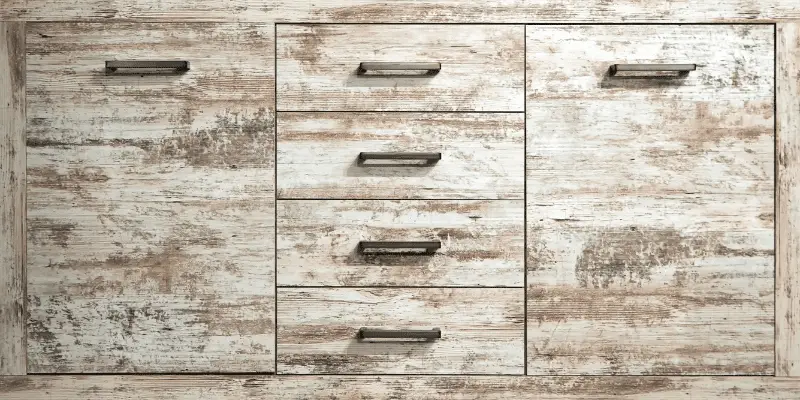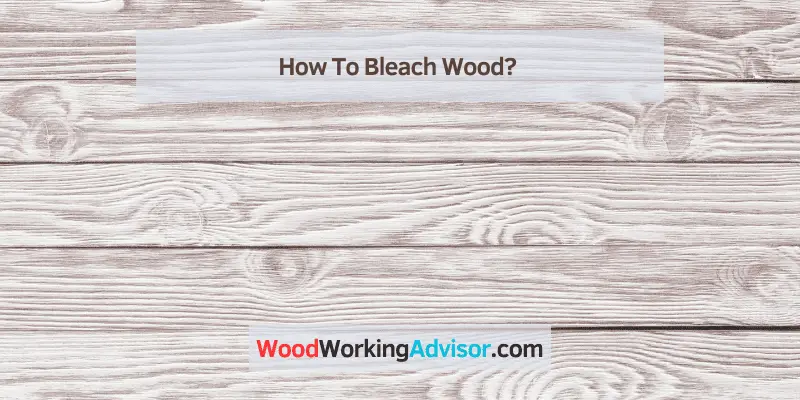Bleached wood furniture is a popular design trend that involves treating wooden pieces to achieve a lighter, more faded appearance. This process typically entails applying a bleaching agent, such as hydrogen peroxide or wood bleach, to the wood’s surface.
To bleach wood, begin by sanding the surface to remove any existing finish. Next, apply a wood bleach solution, following the manufacturer’s instructions. Allow the bleach to penetrate the wood for the recommended time. Rinse the wood thoroughly with water to neutralize the bleach. After drying, sand the wood lightly to remove raised wood fibers. Apply a wood conditioner and stain if desired. Ensure proper ventilation and use protective gear during the process.
The bleach breaks down the natural pigments in the wood, lightening its color and giving it a weathered or driftwood-like look. Bleached wood furniture is favored for its ability to create a coastal or rustic aesthetic in interior design, and it can complement a variety of decor styles, from Scandinavian minimalism to bohemian chic.
This technique not only alters the wood’s color but also enhances its texture, making it a versatile choice for those looking to add a touch of natural, muted elegance to their living spaces.
Bleaching Stained Wood
Bleaching stained wood is a process used to remove or lighten unwanted stains and blemishes from wooden surfaces. This technique involves applying a wood bleach or bleach solution to the stained area, which breaks down the pigments responsible for the discoloration.
There are two primary types of wood bleach: oxalic acid-based bleach for water and rust stains, and chlorine bleach-based products for darker, organic stains. After applying the bleach, the wood may need to be rinsed and neutralized with water to stop the bleaching action.
Bleaching stained wood can be an effective way to restore the natural appearance of wood, particularly when traditional methods like sanding and refinishing aren’t suitable or would result in a loss of wood detail.
Oxalic Acid For Bleaching Wood
Oxalic acid is commonly used for bleaching wood and is particularly effective in removing water and rust stains from wooden surfaces. It works by breaking down and dissolving the iron or mineral deposits responsible for these stains.To use oxalic acid for wood bleaching, you typically mix it with water to create a solution and then apply it to the stained areas.
After the application, you may need to rinse and neutralize the wood with water to halt the bleaching process. Oxalic acid is considered a safer option than chlorine bleach-based products, as it doesn’t cause wood discoloration.
However, it’s crucial to follow safety precautions when working with oxalic acid, including wearing protective gear and ensuring proper ventilation.
Bleached Wood Cabinets
Bleached wood cabinets are a popular choice in modern interior design, offering a distinctive and lightened appearance to kitchen and bathroom cabinetry. This design trend involves treating wooden cabinets with a bleaching agent to achieve a lighter, often white washed or washed-out look.
The bleaching process removes the natural pigments in the wood, resulting in a pale and often rustic aesthetic. This style can create a sense of airiness and a coastal or Scandinavian-inspired feel in a living space, making it a favored choice for those seeking a fresh and contemporary look.
Bleached wood cabinets pair well with various design elements and color schemes, making them a versatile option for both traditional and modern homes.

Bleach Mixture For Cleaning Wood Siding
Creating a bleach mixture for cleaning wood siding involves using a diluted solution to effectively remove mold, mildew, and grime. The mixture typically consists of one part household bleach (sodium hypochlorite) and four parts water.
This 1:4 ratio helps prevent damage to the wood and avoids overly aggressive bleaching. Before applying the mixture, it’s essential to protect nearby plants, wear protective gear, and ensure proper ventilation. Gently scrub the wood siding with the bleach solution using a soft-bristle brush or a pressure washer set to a low setting, being careful not to use excessive force that could harm the wood’s surface.
Afterward, rinse thoroughly with clean water to remove any residual bleach, and allow the wood to dry completely.
FAQ
Can You Use Bleach On Wood?
Yes, you can use bleach on wood, but it should be done with caution and in specific circumstances. Bleach can be employed to remove stains, disinfect, or lighten wood. However, it’s crucial to dilute it properly, typically using a solution of one part household bleach (sodium hypochlorite) to four parts water.
This helps prevent damage or discoloration to the wood. When using bleach on wood, wear protective gear, work in a well-ventilated area, and avoid using excessive force to prevent damage to the wood’s surface.
Always rinse the wood thoroughly with clean water and allow it to dry completely after using bleach to ensure the removal of any residual bleach.
Can You Use Bleach On Wood Floors?
While bleach can be used on wood floors in some situations, it should be done with great care and only as a last resort. Bleach can effectively remove stains and disinfect, but it can also damage the wood and alter its color.
If you decide to use bleach on wood floors, make sure to dilute it significantly, using a mixture of one part household bleach to ten parts water, or even milder. Apply the solution sparingly, avoid leaving it on the wood for an extended period, and rinse thoroughly with clean water.
Always test a small, inconspicuous area first to ensure that the wood won’t be adversely affected by the bleach. In general, it’s advisable to explore alternative cleaning methods specifically designed for wood floors to maintain their finish and appearance.
Does Bleach Damage Wood?
Yes, bleach can damage wood if not used carefully. The active ingredient in household bleach, sodium hypochlorite, is a powerful disinfectant and stain remover, but it can also harm wood.
When bleach is applied to wood in concentrated or undiluted form, or left on for too long, it can cause discoloration, weakening of the wood fibers, and even deterioration of the finish. To minimize the risk of damage, it’s crucial to dilute bleach properly, use the right concentration, and avoid prolonged contact with wood surfaces.
Always rinse the wood thoroughly with clean water and ensure it dries completely after using bleach to remove any residual chemicals and prevent long-term harm. It’s often best to explore wood-friendly cleaning and maintenance methods to protect your wood surfaces effectively.
Will Bleach Kill Mold On Wood?
Yes, bleach can effectively kill mold on wood surfaces. Mold is a common issue on wood, especially in damp or humid environments. To use bleach for mold removal, mix a solution of one part household bleach (sodium hypochlorite) and three parts water.
Apply it to the affected wood surface, scrub gently with a brush, and allow it to sit for about 15 minutes. After that, rinse the wood with clean water to remove any residual bleach and mold. This process can help eliminate the visible mold and prevent its return.
However, it’s essential to ensure the wood is thoroughly dried afterward to prevent further moisture-related issues, as bleach does not offer long-term protection against mold.
What Does Bleach Do To Wood?
Bleach can have several effects on wood, depending on how it’s used. When applied in a concentrated form or left on wood for an extended period, bleach can lighten the wood’s color by removing natural pigments, creating a weathered or whitewashed appearance.
However, it can also damage the wood’s finish, leaving it vulnerable to moisture and UV damage. Prolonged exposure to bleach can weaken the wood fibers, making the wood more prone to splintering and other structural issues. Improper use of bleach can also lead to uneven or blotchy discoloration of the wood, affecting its overall appearance.
To use bleach on wood effectively, it’s important to dilute it properly and apply it carefully to achieve the desired results without causing harm.
Can You Clean Wood Floors With Bleach?
While it is possible to clean wood floors with bleach, it should be done with extreme caution and only in specific situations. Bleach can effectively remove stains and disinfect, but it can also damage the wood and alter its color. If you decide to use bleach on wood floors, it’s essential to dilute it significantly, generally using a mixture of one part household bleach to ten parts water, or even milder.
Apply the solution sparingly, avoid letting it sit on the wood for too long, and rinse thoroughly with clean water. Always test a small, inconspicuous area first to ensure that the wood won’t be adversely affected by the bleach.
In general, it’s advisable to explore alternative cleaning methods specifically designed for wood floors to maintain their finish and appearance without the potential risks associated with bleach.
Can I Spray Bleach On Wood?
Spraying bleach on wood can be done, but it should be approached with caution. When using bleach on wood surfaces, it’s essential to dilute it properly and apply it carefully. If you choose to spray bleach, make sure to use a gentle mist or spray setting to avoid saturating the wood. Use a mixture of one part household bleach to ten parts water or even milder, and apply the solution evenly.
After spraying, leave it on the wood for a short period, typically no more than a few minutes, and then rinse thoroughly with clean water. Ensure that the wood is well-ventilated and completely dried after the process to prevent potential damage. Always test a small, inconspicuous area first to confirm that the wood can withstand the bleach without adverse effects.



One thought on “How To Bleach Wood?”